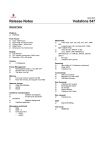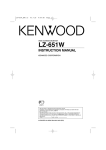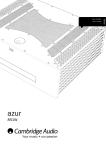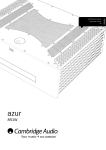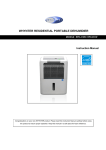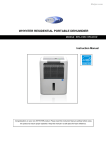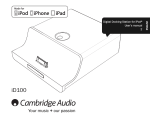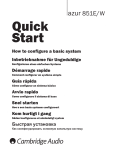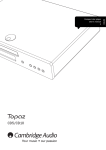Download Cambridge Audio 651W User`s manual
Transcript
User’s manual 2 azur 651W Your music + our passion ENGLISH Power Amplifier Contents Important safety instructions......................................................................3 Make sure you register your purchase. Visit: support.cambridgeaudio.com By registering, you’ll be the first to know about: Future product releases Software upgrades News, events and exclusive offers plus competitions! Limited warranty...........................................................................................4 Rear panel connections...............................................................................5 Front panel...................................................................................................6 Connections..................................................................................................7 Unbalanced stereo connections.............................................................7 Balanced stereo connections..................................................................7 Power syncing (On/Standby control).......................................................8 Powering On/Off the 651W.........................................................................8 Custom installation (C.I.) use......................................................................8 Configuration menu.....................................................................................9 CAP5: Five-way protection system............................................................ 10 This guide is designed to make installing and using this product as easy as possible. Information in this document has been carefully checked for accuracy at the time of printing; however, Cambridge Audio’s policy is one of continuous improvement, therefore design and specifications are subject to change without prior notice. This document contains proprietary information protected by copyright. All rights are reserved. No part of this manual may be reproduced by any mechanical, electronic or other means, in any form, without prior written permission of the manufacturer. All trademarks and registered trademarks are the property of their respective owners. © Copyright Cambridge Audio Ltd 2014. Cambridge Audio and the Cambridge Audio logo are trademarks of Cambridge Audio. Other brands mentioned are trademarks of their respective owners and are used for reference purposes only. 2 Technical specifications............................................................................ 11 Troubleshooting......................................................................................... 11 azur 651W ENGLISH Important safety instructions For your own safety please read the following important safety instructions carefully before attempting to connect this unit to the mains power supply. They will also enable you to get the best performance from and prolong the life of the unit: 1. Read these instructions. 2. Keep these instructions. 3. Heed all warnings. 4. Follow all instructions. 5. Do not use this apparatus near water. 6. Clean only with a dry cloth. 7. Do not block any ventilation openings. Install in accordance with the manufacturer’s instructions. 8. Do not install near any heat sources such as radiators, heat registers, stoves, or other apparatus (including other amplifiers) that produce heat. 9. Do not defeat the safety purpose of the polarized or grounding-type plug. A polarized plug has two blades with one wider than the other. A grounding-type plug has two blades and a third grounding prong. The wide blade or the third prong are provided for your safety. If the provided plug does not fit into your outlet, consult an electrician for replacement of the obsolete outlet. 10. Protect the power cord from being walked on or pinched, particularly at plugs, convenience receptacles and the point where they exit from the apparatus. 11. Only use attachments/accessories specified by the manufacturer. 12. Use with only the cart, stand, tripod, bracket, or table specified by the manufacturer, or sold with the apparatus. When a cart is used, use caution when moving the cart/ apparatus combination to avoid injury from tip-over. 13. Unplug this apparatus during lightning storms or when unused for long periods of time. 14. Refer all servicing to qualified service personnel. Servicing is required when the apparatus has been damaged in any way, such as the power-supply cord or plug having been damaged, liquid has been spilled or objects have fallen into the apparatus, the apparatus has been exposed to rain or moisture, does not operate normally, or has been dropped. WARNING – To reduce the risk of fire or electric shock, do not expose this unit to rain or moisture. – Batteries (battery pack or batteries installed) shall not be exposed to excessive heat such as sunshine, fire or the like. The unit is of Class 1 construction and must be connected to a mains socket outlet with a protective earthing connection. The unit must be installed in a manner that makes disconnection of the mains plug from the mains socket outlet (or appliance connector from the rear of the unit) possible. Where the mains plug is used as the disconnect device, the disconnect device shall remain readily operable. Only use the mains cord supplied with this unit. Please ensure there is ample ventilation. We recommend that you do not place the unit in an enclosed space; if you wish to place the unit on a shelf, use the top shelf to allow maximum ventilation. Do not put any objects on top of this unit. Do not situate it on a rug or other soft surface and do not obstruct any air inlets or outlet grilles. Do not cover the ventilation grilles with items such as newspapers, tablecloths, curtains, etc. This unit must not be used near water or exposed to dripping or splashing water or other liquids. No objects filled with liquid, such as vases, shall be placed on the unit. The lightning flash with the arrowhead symbol within an equilateral triangle is intended to alert the user to the presence of un-insulated ‘dangerous voltage’ within the product’s enclosure that may be of sufficient magnitude to constitute a risk of electric shock to persons. The exclamation point within an equilateral triangle is intended to alert the user to the presence of important operating and maintenance instructions in the service literature relevant to this appliance. WEEE symbol The crossed-out wheeled bin is the European Union symbol for indicating separate collection for electrical and electronic equipment. This product contains electrical and electronic equipment which should be reused, recycled or recovered and should not be disposed of with unsorted regular waste. Please return the unit or contact the authorised dealer from whom you purchased this product for more information. CE mark This product complies with European Low Voltage (2006/95/ EC), Electromagnetic Compatibility (2004/108/EC) and Environmentally-friendly design of Energy-related Products (2009/125/ EC) Directives when used and installed according to this instruction manual. For continued compliance only Cambridge Audio accessories should be used with this product and servicing must be referred to qualified service personnel. C-Tick mark This product meets the Australian Communications Authority’s Radio communications and EMC requirements. Gost-R Mark This product meets Russian electronic safety approvals. FCC regulations NOTE: THE MANUFACTURER IS NOT RESPONSIBLE FOR ANY RADIO OR TV INTERFERENCE CAUSED BY UNAUTHORIZED MODIFICATIONS TO THIS EQUIPMENT. SUCH MODIFICATIONS COULD VOID THE USER AUTHORITY TO OPERATE THE EQUIPMENT. This equipment has been tested and found to comply with the limits for a Class B digital device, pursuant to Part 15 of the FCC Rules. These limits are designed to provide reasonable protection against harmful interference in a residential installation. This equipment generates, uses and can radiate radio frequency energy and, if not installed and used in accordance with the instructions, may cause harmful interference to radio communications. However, there is no guarantee that interference will not occur in a particular installation. If this equipment does cause harmful interference to radio or television reception, which can be determined by turning the equipment off and on, the user is encouraged to try to correct the interference by one or more of the following measures: - Re-orient or relocate the receiving antenna. - Increase the separation between the equipment and receiver. - Connect the equipment into an outlet on a circuit different from that to which the receiver is connected. - Consult the dealer or an experienced radio/TV technician for help. 3 Limited warranty Ventilation IMPORTANT – The unit will become hot when in use. Do not stack multiple units on top of each other. Do not place in an enclosed area such as a bookcase or in a cabinet without sufficient ventilation. Do not remove the feet from this product they are required to ensure enough air flow. Ensure that small objects do not fall through any ventilation grille. If this happens, switch off immediately, disconnect from the mains supply and contact your dealer for advice. Positioning Choose the installation location carefully. Avoid placing it in direct sunlight or close to a source of heat. No naked flame sources, such as lighted candles, should be placed on the unit. Also avoid locations subject to vibration and excessive dust, cold or moisture. The unit can be used in a moderate climate. This unit must be installed on a sturdy, level surface. Do not place in a sealed area such as a bookcase or in a cabinet. Do not place the unit on an unstable surface or shelf. The unit may fall, causing serious injury to a child or adult as well as serious damage to the product. Do not place other equipment on top of the unit. Due to stray magnetic fields, turntables or CRT TVs should not be located nearby due to possible interference. Electronic audio components have a running in period of around a week (if used several hours per day). This will allow the new components to settle down and the sonic properties will improve over this time. Power sources The unit should be operated only from the type of power source indicated on the marking label. If you are not sure of the type of power-supply to your home, consult your product dealer or local power company. This unit can be left in Standby mode when not in use and will draw <0.5W in this state. To turn the unit off, switch off at the rear panel. If you do not intend to use this unit for a long period of time, unplug it from the mains socket. Overloading Do not overload wall outlets or extension cords as this can result in a risk of fire or electric shock. Overloaded AC outlets, extension cords, frayed power cords, damaged or cracked wire insulation and broken plugs are dangerous. They may result in a shock or fire hazard. Be sure to insert each power cord securely. To prevent hum and noise, do not bundle the interconnect leads with the power cord or speaker leads. Cleaning To clean the unit, wipe its case with a dry, lint-free cloth. Do not use any cleaning fluids containing alcohol, ammonia or abrasives. Do not spray an aerosol at or near the unit. Battery disposal Batteries may contain substances harmful to the environment. Please dispose of any discharged batteries with due consideration and in accordance with local environmental/electronic recycling guidelines. Loudspeakers Before making any connections to loudspeakers, make sure all power is turned off and only use suitable interconnects. Servicing These units are not user serviceable. Never attempt to repair, disassemble or reconstruct the unit if there seems to be a problem. A serious electric shock could result if this precautionary measure is ignored. In the event of a problem or failure, please contact your dealer. Cambridge Audio warrants this product to be free from defects in materials and workmanship (subject to the terms set forth below). Cambridge Audio will repair or replace (at Cambridge Audio’s option) this product or any defective parts in this product. Warranty periods may vary from country to country. If in doubt consult your dealer and ensure that you retain proof of purchase. To obtain warranty service, please contact the Cambridge Audio authorised dealer from which you purchased this product. If your dealer is not equipped to perform the repair of your Cambridge Audio product, it can be returned by your dealer to Cambridge Audio or an authorised Cambridge Audio service agent. You will need to ship this product in either its original packaging or packaging affording an equal degree of protection. Proof of purchase in the form of a bill of sale or receipted invoice, which is evidence that this product is within the warranty period, must be presented to obtain warranty service. This Warranty is invalid if (a) the factory-applied serial number has been altered or removed from this product or (b) this product was not purchased from a Cambridge Audio authorised dealer. You may call Cambridge Audio or your local country Cambridge Audio distributor to confirm that you have an unaltered serial number and/or you made a purchase from a Cambridge Audio authorised dealer. This Warranty does not cover cosmetic damage or damage due to acts of God, accident, misuse, abuse, negligence, commercial use, or modification of, or to any part of, the product. This Warranty does not cover damage due to improper operation, maintenance or installation, or attempted repair by anyone other than Cambridge Audio or a Cambridge Audio dealer, or authorised service agent which is authorised to do Cambridge Audio warranty work. Any unauthorised repairs will void this Warranty. This Warranty does not cover products sold AS IS or WITH ALL FAULTS. REPAIRS OR REPLACEMENTS AS PROVIDED UNDER THIS WARRANTY ARE THE EXCLUSIVE REMEDY OF THE CONSUMER. CAMBRIDGE AUDIO SHALL NOT BE LIABLE FOR ANY INCIDENTAL OR CONSEQUENTIAL DAMAGES FOR BREACH OF ANY EXPRESS OR IMPLIED WARRANTY IN THIS PRODUCT. EXCEPT TO THE EXTENT PROHIBITED BY LAW, THIS WARRANTY IS EXCLUSIVE AND IN LIEU OF ALL OTHER EXPRESS AND IMPLIED WARRANTIES WHATSOEVER INCLUDING, BUT NOT LIMITED TO, THE WARRANTY OF MERCHANTABILITY AND FITNESS FOR A PRACTICAL PURPOSE. Some countries and US states do not allow the exclusion or limitation of incidental or consequential damages or implied warranties so the above exclusions may not apply to you. This Warranty gives you specific legal rights, and you may have other statutory rights, which vary from state to state or country to country. For any service, in or out of warranty, please contact your dealer. Plug Fitting Instructions (UK only) The cord supplied with this appliance is factory-fitted with a UK mains plug fitted with a 13-amp fuse inside. If it is necessary to change the fuse, it is important that a 5-amp fuse is used. If the plug needs to be changed because it is not suitable for your socket, or becomes damaged, it should be cut off and an appropriate plug fitted following the wiring instructions below. The plug must then be disposed of safely, as insertion into a mains socket is likely to cause an electrical hazard. Should it be necessary to fit a 3-pin BS mains plug to the power cord, the wires should be fitted as shown in this diagram. The colours of the wires in the mains lead of this appliance may not correspond with the coloured markings identifying the terminals in your plug. Connect them as follows: The wire which is coloured BLUE must be connected to the terminal which is marked with the letter ‘N’ or coloured BLACK. The wire which is coloured BROWN must be connected to the terminal which is marked with the letter ‘L’ or coloured RED. The wire which is coloured GREEN/ YELLOW must be connected to the terminal which is marked with the letter ‘E’ or coloured GREEN. If a standard 13-amp (BS 1363) plug is used, a 5-amp fuse must be fitted or, if any other type of plug is used, a 5-amp fuse must be fitted, either in the plug or adaptor, or on the distribution board. 4 azur 651W ENGLISH Rear panel connections 1 2 4 9 10 3 5 6 7 8 1. Power On/Off 7. Trigger In, Out/Thru Switches the unit on and off. If the 651W is not going to be used for long periods of time it should be turned off using this switch. For Custom Install use or with preamps and with trigger outputs, the 651W can be turned on and off (i.e. brought in and out of Standby mode) by the presence of 5-12V DC at the Trigger input. A trigger input will also produce an internally generated 12V DC trigger output at the Output/Thru connection. Turning the 651W on from the front panel also produces a 12V DC trigger output at the Output/Thru connection. This can be used to turn on/Standby other connected power amplifiers or other equipment if desired. Refer to the ‘Power syncing’ section of this manual for more information. 2. Mains Voltage Selector Switch (CU version only) Switches the 651W mains voltage between 100V and 115V. Note: For use by Cambridge Audio service personnel only! 3. AC power socket Once you have completed all connections to the unit, plug the AC power cable into an appropriate mains socket then switch on. Your unit is now ready for use. 4. Loudspeaker terminals Two sets of loudspeaker terminals are available, a main loudspeaker terminals (top row) and secondary loudspeaker terminals (bottom row). Connect the wires from your left channel loudspeaker to the LEFT positive and negative terminals, and the wires from the right channel loudspeaker to the RIGHT positive and negative terminals. In each case, the red terminal is the positive output and the black terminal is the negative output. Care should be taken to ensure no stray strands of wire are shorting speaker outputs together. Please ensure that the loudspeaker terminals have been tightened adequately to provide a good electrical connection. It is possible for the sound quality to be affected if the screw terminals are loose. 8. Input Type switch Use to select a balanced or unbalanced connection type for the input. Input types The 651W features either unbalanced (phono/RCA) or balanced (XLR) input connections. Either type may be used but not both at the same time. The balanced connection is the higher quality option and can reject noise and interference in the cable when used with other equipment that supports this function. An XLR connector is wired Pin 1 - Ground; Pin 2 - Hot (in-phase); Pin 3 - Cold (phase-inverted). Use the Input Type switch to select the connection type you wish to use. When using either the balanced or unbalanced input, make sure that no cables or equipment are connected to the unused input, as this may degrade operation. The unused input does not need to be terminated and this should not be done. Warning! DO NOT switch between input types when the 651W is on. 5. Control Bus 9. Balanced Audio Input In - Allows un-modulated commands from multi-room systems or other components to be received by the unit. For connection to the balanced XLR outputs of suitable pre-amplifiers that have this kind of output (such as our own 851E model). The preamplifier used should be capable of providing at least 1V rms of output per phase (i.e. at both of + and – terminals of the XLR, more is also fine). Nearly all modern pre-amplifiers fulfill this requirement. Out - Loop out for Control Bus commands to another unit. The 651W can also be switched between On and Standby mode by connecting the Control Bus output of an 851E pre-amplifier to the Control Bus input of the 651W. Refer to the ‘Power syncing’ section of this manual for more information. 6. IR (Infra-Red) Emitter In Allows modulated IR commands from multi-room systems or IR repeater systems to be received by the unit. Commands received here are not looped out of the Control Bus. Refer to the ‘Custom installation’ section for more information. 10. Unbalanced Audio Input For connection to the normal (single ended) RCA/Phono outputs of a suitable pre-amplifier (such as our own 851E model). The pre-amplifier used should be capable of providing at least 1V rms of output (more is fine). Nearly all modern pre-amplifiers fulfil this requirement. 5 Front panel 1 2 3 4 2 3 4 1. Standby/On 4. Clipping Switches the unit between Standby mode (indicated by dim power LED) and On (indicated by bright power LED). Standby mode is a low power mode where the power consumption is less than 0.5 Watts. The unit should be left in Standby mode when not in use. This LED indicates that the 651W has detected that either the Left or Right channel is being overdriven or clipped. When the 651W is switched out of Standby mode it will automatically check for faults and allow the power amplifier stages to stabilise before un-muting the speaker outputs. Clipping distortion is caused at high volume levels when the output signal attempts to go outside the maximum voltage that the amplifier can provide, causing the tops of the signal to flatten off. Note: The protection LEDs will flash whilst this check is being done. Auto Power Down (APD) This product has Auto Power Down enabled as default. After a period of inactivity, the product will automatically switch to Standby. See later section for further details. Clipping 2. Output Indicates that the Left or Right output is active. The LED (light-emitting diode) is on for an active output, off for inactive (i.e. muted). 3. Protection If this LED is constantly on the 651W has detected a fault on either the Left or Right channel and is protecting itself. 6 When the 651W detects clipping this LED will briefly flash. If the clipping reaches a dangerous amount that could damage the amplifier or attached speakers the unit will then go into protection. azur 651W The 651W features both balanced (XLR) and unbalanced (RCA/Phono) output connections. For the best quality we recommend you use a balanced output with pre-amplifiers that feature this connection (such as our own Stream Magic 6). Before making any connections to loudspeakers, make sure all power is turned off and only use suitable interconnects (e.g. banana plugs). Ensure that the positive (+) and negative (-) connections are matched. Your loudspeaker may have more than one pair of connecting terminals; LF (Low Frequency) and HF (High Frequency). For single-wiring it is recommended to connect to the LF terminals. The metal strip connecting the low-frequency terminals to the high-frequency terminals must not be removed (only to be removed for a bi-wiring system). Unbalanced stereo connections The diagram below shows the 651W connected to a Stream Magic 6 using the Unbalanced Audio inputs via phono/RCA connectors, single wired to a pair of loudspeakers. When using unbalanced (phono/RCA) connections, the Input Type switch on the 651W must be in the ‘Unbalanced’ position. Stream Magic 6 651W Balanced stereo connections The diagram below shows the 651W connected to a Stream Magic 6 using the Balanced Audio inputs via three-pin XLR connectors, single wired to a pair of loudspeakers. When using balanced (XLR) connections, the Input Type switch on the 651W must be in the ‘Balanced’ position. Stream Magic 6 651W 7 ENGLISH Connections Power syncing (On/Standby control) When going in/out of Standby mode the Azur 851E pre-amplifier can (if desired) automatically control the 651W when connected via the Control Bus sockets (the Control Bus sockets are colour-coded orange on the rear panels of compatible Azur models). For this feature to work the units must be connected together by RCA/phono leads. No further setup is necessary. Connect the Control Bus Out from the 851E to the Control Bus In on the 651W. Continue the chain to other Azur models if it is required to sync more units (refer to the 851E’s own manual for more information as this requires some setup). Note: The 851E features a Trigger Out which can alternatively be used to control the 651W’s Standby/On status if desired. Again, the procedure is simply to connect the two units together (using a 3.5mm to 3.5mm mono mini-jack lead in this case). Control Bus is the recommended method when using an 851E and other Cambridge Audio equipment with Control Bus In/Out. Trigger In/Out can be useful if the 651W (and indeed 851E) is desired to be controlled by other equipment that features trigger outputs (Custom install and/or Multi-Room Systems etc). 851E 1. Control Bus 2. Trigger In/Out 2 1 Powering On/Off the 651W Custom installation (C.I.) use As well as simply using the front panel button the 651W features multiple ways it can be automatically powered on and off. Control Bus The 651W features a Control Bus input/output that IR Emitter In In Out allow un-modulated remote control commands (positive logic, TTL level) to be received electrically by the unit and looped to another unit if desired. These control commands are typically generated by custom installation (multi-room) systems or remote IR receiver systems. The Control Bus sockets are colour-coded orange. A trigger 5-12V AC or DC input to the Trigger In on the rear panel can power up or down the unit from custom install systems or preamps with trigger outputs. This is an ‘edge triggered’ input so that the 651W will power on with a zero-to-positive voltage transition and power down with a positive voltage to zero transition. Alternatively the 651W features a Control Bus Input for use with our matching 851E preamp that allows a single RCA/Phono to RCA/Phono cable to be connected between them that allows the 851E preamp to communicate with the 651W and automatically control its power status. For custom install situations it is also possible to send Infra Red or Control Bus commands (see our website for the code table) to the 651W and also affect power control. Lastly the 651W can sense its audio inputs and automatically power up if a signal is present and conversely Auto-Power Down if no signal has been present for 30 mins. To enable/disable Auto Power Up/Auto Power Down see the next section on the hidden configuration menu. An IR Emitter Input is also provided that allows modulated IR remote control commands to be received electrically by the unit. Commands on this input operate the unit only and are not looped out demodulated on the Control Bus Output. The unit responds to ‘direct’ IR/Control codes as well as toggle codes for some features to simplify programming custom installation systems. Special direct On/Off and Mute commands can be accessed from the 851E pre-amplifier remote control for teaching into C.I. systems as follows: 1.Press and hold the Standby/On button. The remote first generates a standby (toggle) command. Keep the button held down, after 12 seconds an amplifier “On” command will be generated. If the button is kept held down for a further 12 seconds, an amplifier player “Off” command is generated. 2.Press and hold the Mute button. The remote first generates a mute (toggle) command. Keep the button held down, after 12 seconds a “Mute on” command will be generated. If the button is kept held down for a further 12 seconds, a “Mute off” command is generated. These commands are recognised by the 651W via the IR Emitter input. A code table for this product is available on the Cambridge Audio website: www.cambridge-audio.com 8 RS232C 651W azur 651W ENGLISH Configuration menu In Standby mode, press and hold the Standby/On button to enter the Configuration menu. The Left and Right ‘Output’ LED will start blinking to indicate that you are now in the Configuration menu. Pressing the Standby/On button will shuffle through these different setting options: Right ‘Protection’ LED - Auto power down enabled (by default). Right ‘Protection’ and ‘Clipping’ LED - Auto power down and auto power up enabled. Left and Right ‘Output’ LED - All features are now disabled. To exit the Configuration menu, press and hold the Standby/On button. 9 CAP5: Five-way protection system Cambridge Audio has developed a proprietary protection system to ensure reliability and long life of its amplifiers. This protection system comprises five main protection methods: 5. Intelligent clipping detection 1. DC detection Description – CAP5 has the ability to detect when the amplifier starts to clip or overdrive at its output, which can damage loudspeakers and degrade the sound. Clipping distortion is caused at high volume levels when the output signal briefly goes outside the maximum voltage that the amplifier can provide, causing the tops of the signal to flatten off. Indicator – Unit has switched off during operation, protection LED constantly flashes in single bursts. Description – CAP5 offers loudspeaker protection if the output of the amplifier goes to a high constant voltage (DC). This is a rare fault, although detecting it could just save those expensive loudspeakers. Remedy – Due to the necessary sensitivity of the DC protection circuit, hard clipping of the amplifier may cause DC protection to be triggered. If this fault occurs please switch the unit off, power up again and check operation with a reduced volume level. If the DC fault occurs again please contact your dealer for service. 2. Over temperature detection Indicator – Unit has switched off during operation, protection LED constantly flashes in bursts of two. Description – CAP5 includes temperature detection which constantly monitors the heat generated by the output transistors. If the monitored temperature reaches a high level (suitably within the limits of the output devices) the amplifier will automatically switch into a fault mode. If the loudspeaker impedance is low, the temperature of the amplifier may rise faster as the amplifier is working harder. If the amplifier is mounted in a cabinet or the ventilation slots are obstructed, the over-temperature detection may activate/reactivate after a short listening time. Remedy – The unit is not damaged, although it should be left for 15 minutes to cool down before being switched out of Standby. 3. Overvoltage/overcurrent detection Indicator – Unit has switched off during operation, protection LED constantly flashes in bursts of three. Description – CAP5 offers V/I protection by constantly monitoring the output transistors to keep them working inside their Safe Operating Area (SOA). The SOA is a set of limits given by the output transistor manufacturer to ensure reliability. V/I also protects the amplifier against short-circuits on the speaker terminals during use. Remedy – The amplifier is being used outside its performance envelope. Reduce the volume. Also check to see if there is a short- or partial shortcircuit between the loudspeaker terminals. Note: If the indication remains the same and multiple loudspeakers are being used on each loudspeaker output, then please remove a pair and retry. If too many loudspeakers are connected to any amplifier, causing the load resistance to drop too low, the amplifier will be overdriven. CAP5 will detect this situation. If the indication remains the same with only one set of loudspeakers connected, there may be a fault with one or both of the loudspeakers. 4. Short-circuit detection Indicator – As the unit attempts to come out of Standby mode, the protection LED flashes in bursts of four. Description – During power up from Standby, CAP5 performs a check on the loudspeaker terminals to see if a short across the terminals has been accidentally introduced. If the resistance measured across the loudspeaker terminals is too low, the unit will remain in Standby mode until the fault has been removed and power up is re-attempted. Remedy – User-related fault. There may be a short-circuit between the loudspeaker terminals. Check all loudspeaker connections before attempting to switch the unit out of Standby. 10 Indicator – Clipping LED will flash if the audio output is at/above the clipping level. Clipping Technical specifications Troubleshooting Power Output 100W 8 Ohms THD (unweighted) < 0.001% 1kHz < 0.005% 20Hz - 20kHz There is no power Frequency Response 5Hz - 80kHz ±1dB S/N ratio (ref 1W/8 Ohm) > 90 dB (unweighted) Sensitivity1.5V rms unbalanced 1.5 + 1.5V rms balanced Input impedancesBalanced input 38 kOhm Unbalanced input 68 kOhm Damping factor > 125 at 1 kHz Trigger In 5 – 12V AC or DC Trigger Out 12V DC @ 100mA Power consumption Maximum 750W Active (no signal) < 45W Standby < 0.5W Dimensions (H x W x D)115 x 430 x 340mm (4.5 x 16.9 x 13.4") Weight 10.7kg (23.5lbs) 651W ENGLISH azur Ensure the AC power cord is connected securely. Ensure the plug is fully inserted into the wall socket and is switched on. Check fuse in the mains plug or adaptor. There is no sound Make sure the unit is not in Standby mode. Check that your source component is properly connected. Check that your loudspeakers are properly connected. Check that the Left and Right Input Type switches are in the correct position (Balanced or Unbalanced). There is no sound on one channel Check that your source component is properly connected. Check that your loudspeakers are properly connected. Check that the Left and Right Input Type switches are in the correct position (Balanced or Unbalanced). Check that the Stereo/Mono mode switch is in the correct position (Stereo or Mono). Check that the Mono mode switch is in the correct position (Bi-Amp or Bridged). There is a loud buzz or hum Ensure that no interconnects are loose or defective. Ensure that your tape deck/turntable is not too close to the unit. There is weak bass or diffused stereo imaging Ensure that the loudspeakers are not wired out of phase. For more frequently asked questions (FAQs), technical advice and information on getting the most out of your 651W, please visit the Support section on Cambridge Audio’s website: www.cambridge-audio.com/support.php 11 Cambridge Audio is a brand of Audio Partnership Plc Registered Office: Gallery Court, Hankey Place London SE1 4BB, United Kingdom Registered in England No. 2953313 © 2014 Cambridge Audio Ltd AP32813/1 www.cambridge-audio.com












